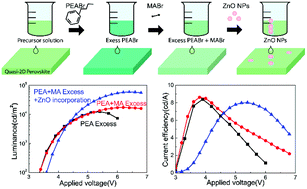Phase control of quasi-2D perovskites and improved light-emitting performance by excess organic cations and nanoparticle intercalation†
Abstract
The optoelectronic properties of quasi-two-dimensional organic–inorganic hybrid perovskites can be tuned by controlling the formation of Ruddlesden–Popper type phases, which enables diverse device applications such as photovoltaics and light-emitting diodes (LEDs). Herein, the influence of excess organic cations on the phase formation of (PEA)2MAn−1PbnBr3n+1 is systematically investigated with various mixing ratios to discover the phase distribution beneficial for light-emitting diodes. It is found that PEA cations exceeding Pb ions in molar ratio are required to produce small-n phases in the films with a strong photoluminescence, while excess MA cations enable the formation of more large-n phases. Low electrical conductivity inherent to the properties of quasi-2D perovskites is further lowered by the introduction of excess organic cations. This is overcome by the intercalation of zinc oxide (ZnO) nanoparticles (NPs) into the blocking layers composed of PEA cations. Importantly, these metal oxide NPs also modulate the phase distribution, enabling the realization of bright green quasi-2D perovskites with a better stability and a maximum luminance of nearly 60 000 cd m−2, which is the highest brightness compared to the so far reported quasi-2D perovskite LEDs incorporating organic cations.



 Please wait while we load your content...
Please wait while we load your content...